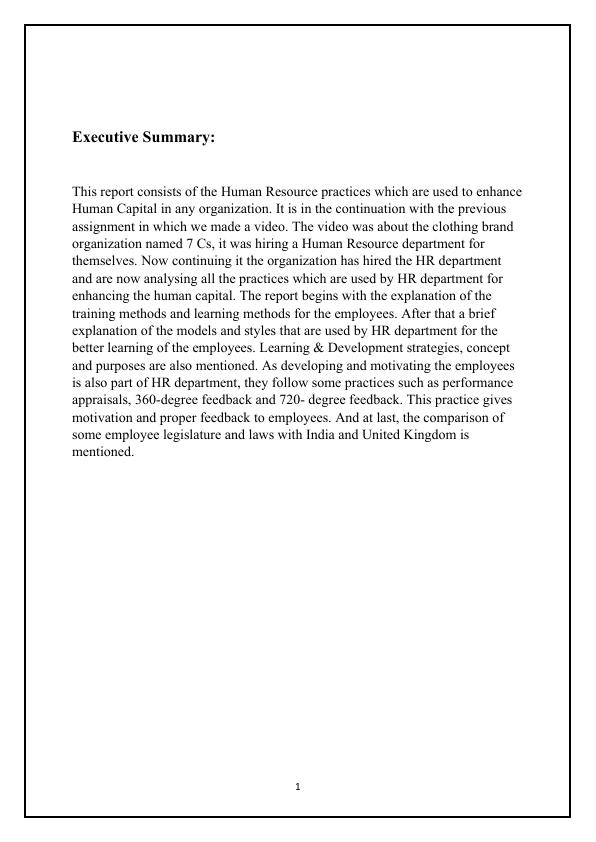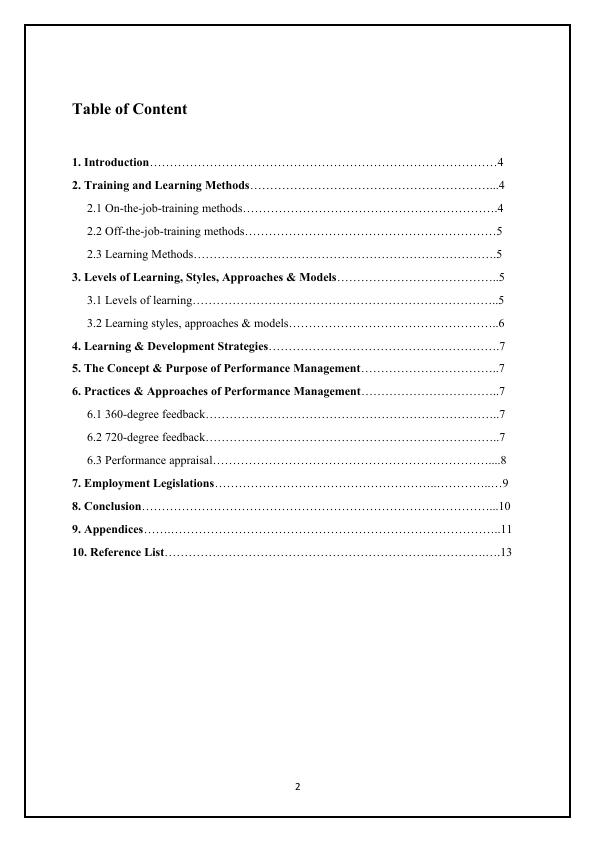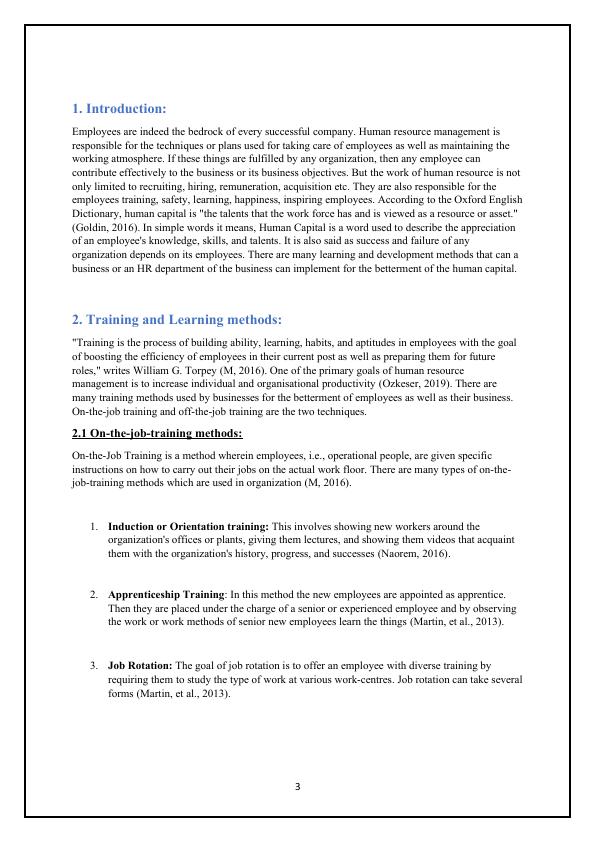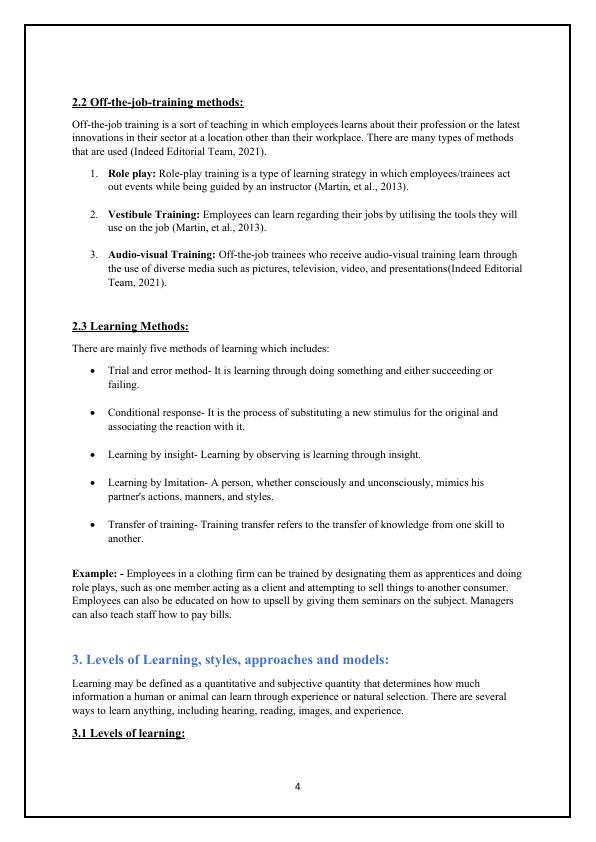Human Resource Practices for Enhancing Human Capital
13 Pages3301 Words387 Views
Added on 2022-03-30
About This Document
In this document, we will discuss Human Resource Practices that are used to enhance human capital in any organization. The report begins with an explanation of the training methods and learning methods for the employees. After that a brief explanation of the models and styles that are used by the HR department for the better learning of the employees. Also, we cover learning & development strategies, concept and purposes.
Human Resource Practices for Enhancing Human Capital
Added on 2022-03-30
ShareRelated Documents
Executive Summary:
This report consists of the Human Resource practices which are used to enhance
Human Capital in any organization. It is in the continuation with the previous
assignment in which we made a video. The video was about the clothing brand
organization named 7 Cs, it was hiring a Human Resource department for
themselves. Now continuing it the organization has hired the HR department
and are now analysing all the practices which are used by HR department for
enhancing the human capital. The report begins with the explanation of the
training methods and learning methods for the employees. After that a brief
explanation of the models and styles that are used by HR department for the
better learning of the employees. Learning & Development strategies, concept
and purposes are also mentioned. As developing and motivating the employees
is also part of HR department, they follow some practices such as performance
appraisals, 360-degree feedback and 720- degree feedback. This practice gives
motivation and proper feedback to employees. And at last, the comparison of
some employee legislature and laws with India and United Kingdom is
mentioned.
1
This report consists of the Human Resource practices which are used to enhance
Human Capital in any organization. It is in the continuation with the previous
assignment in which we made a video. The video was about the clothing brand
organization named 7 Cs, it was hiring a Human Resource department for
themselves. Now continuing it the organization has hired the HR department
and are now analysing all the practices which are used by HR department for
enhancing the human capital. The report begins with the explanation of the
training methods and learning methods for the employees. After that a brief
explanation of the models and styles that are used by HR department for the
better learning of the employees. Learning & Development strategies, concept
and purposes are also mentioned. As developing and motivating the employees
is also part of HR department, they follow some practices such as performance
appraisals, 360-degree feedback and 720- degree feedback. This practice gives
motivation and proper feedback to employees. And at last, the comparison of
some employee legislature and laws with India and United Kingdom is
mentioned.
1

Table of Content
1. Introduction.......................................................................................4
2. Training and Learning Methods...............................................................4
2.1 On-the-job-training methods................................................................4
2.2 Off-the-job-training methods...............................................................5
2.3 Learning Methods............................................................................5
3. Levels of Learning, Styles, Approaches & Models.........................................5
3.1 Levels of learning.............................................................................5
3.2 Learning styles, approaches & models.....................................................6
4. Learning & Development Strategies..........................................................7
5. The Concept & Purpose of Performance Management...................................7
6. Practices & Approaches of Performance Management...................................7
6.1 360-degree feedback..........................................................................7
6.2 720-degree feedback..........................................................................7
6.3 Performance appraisal.........................................................................8
7. Employment Legislations.........................................................................9
8. Conclusion..........................................................................................10
9. Appendices..........................................................................................11
10. Reference List.....................................................................................13
2
1. Introduction.......................................................................................4
2. Training and Learning Methods...............................................................4
2.1 On-the-job-training methods................................................................4
2.2 Off-the-job-training methods...............................................................5
2.3 Learning Methods............................................................................5
3. Levels of Learning, Styles, Approaches & Models.........................................5
3.1 Levels of learning.............................................................................5
3.2 Learning styles, approaches & models.....................................................6
4. Learning & Development Strategies..........................................................7
5. The Concept & Purpose of Performance Management...................................7
6. Practices & Approaches of Performance Management...................................7
6.1 360-degree feedback..........................................................................7
6.2 720-degree feedback..........................................................................7
6.3 Performance appraisal.........................................................................8
7. Employment Legislations.........................................................................9
8. Conclusion..........................................................................................10
9. Appendices..........................................................................................11
10. Reference List.....................................................................................13
2

1. Introduction:
Employees are indeed the bedrock of every successful company. Human resource management is
responsible for the techniques or plans used for taking care of employees as well as maintaining the
working atmosphere. If these things are fulfilled by any organization, then any employee can
contribute effectively to the business or its business objectives. But the work of human resource is not
only limited to recruiting, hiring, remuneration, acquisition etc. They are also responsible for the
employees training, safety, learning, happiness, inspiring employees. According to the Oxford English
Dictionary, human capital is "the talents that the work force has and is viewed as a resource or asset."
(Goldin, 2016). In simple words it means, Human Capital is a word used to describe the appreciation
of an employee's knowledge, skills, and talents. It is also said as success and failure of any
organization depends on its employees. There are many learning and development methods that can a
business or an HR department of the business can implement for the betterment of the human capital.
2. Training and Learning methods:
"Training is the process of building ability, learning, habits, and aptitudes in employees with the goal
of boosting the efficiency of employees in their current post as well as preparing them for future
roles," writes William G. Torpey (M, 2016). One of the primary goals of human resource
management is to increase individual and organisational productivity (Ozkeser, 2019). There are
many training methods used by businesses for the betterment of employees as well as their business.
On-the-job training and off-the-job training are the two techniques.
2.1 On-the-job-training methods:
On-the-Job Training is a method wherein employees, i.e., operational people, are given specific
instructions on how to carry out their jobs on the actual work floor. There are many types of on-the-
job-training methods which are used in organization (M, 2016).
1. Induction or Orientation training: This involves showing new workers around the
organization's offices or plants, giving them lectures, and showing them videos that acquaint
them with the organization's history, progress, and successes (Naorem, 2016).
2. Apprenticeship Training: In this method the new employees are appointed as apprentice.
Then they are placed under the charge of a senior or experienced employee and by observing
the work or work methods of senior new employees learn the things (Martin, et al., 2013).
3. Job Rotation: The goal of job rotation is to offer an employee with diverse training by
requiring them to study the type of work at various work-centres. Job rotation can take several
forms (Martin, et al., 2013).
3
Employees are indeed the bedrock of every successful company. Human resource management is
responsible for the techniques or plans used for taking care of employees as well as maintaining the
working atmosphere. If these things are fulfilled by any organization, then any employee can
contribute effectively to the business or its business objectives. But the work of human resource is not
only limited to recruiting, hiring, remuneration, acquisition etc. They are also responsible for the
employees training, safety, learning, happiness, inspiring employees. According to the Oxford English
Dictionary, human capital is "the talents that the work force has and is viewed as a resource or asset."
(Goldin, 2016). In simple words it means, Human Capital is a word used to describe the appreciation
of an employee's knowledge, skills, and talents. It is also said as success and failure of any
organization depends on its employees. There are many learning and development methods that can a
business or an HR department of the business can implement for the betterment of the human capital.
2. Training and Learning methods:
"Training is the process of building ability, learning, habits, and aptitudes in employees with the goal
of boosting the efficiency of employees in their current post as well as preparing them for future
roles," writes William G. Torpey (M, 2016). One of the primary goals of human resource
management is to increase individual and organisational productivity (Ozkeser, 2019). There are
many training methods used by businesses for the betterment of employees as well as their business.
On-the-job training and off-the-job training are the two techniques.
2.1 On-the-job-training methods:
On-the-Job Training is a method wherein employees, i.e., operational people, are given specific
instructions on how to carry out their jobs on the actual work floor. There are many types of on-the-
job-training methods which are used in organization (M, 2016).
1. Induction or Orientation training: This involves showing new workers around the
organization's offices or plants, giving them lectures, and showing them videos that acquaint
them with the organization's history, progress, and successes (Naorem, 2016).
2. Apprenticeship Training: In this method the new employees are appointed as apprentice.
Then they are placed under the charge of a senior or experienced employee and by observing
the work or work methods of senior new employees learn the things (Martin, et al., 2013).
3. Job Rotation: The goal of job rotation is to offer an employee with diverse training by
requiring them to study the type of work at various work-centres. Job rotation can take several
forms (Martin, et al., 2013).
3

2.2 Off-the-job-training methods:
Off-the-job training is a sort of teaching in which employees learns about their profession or the latest
innovations in their sector at a location other than their workplace. There are many types of methods
that are used (Indeed Editorial Team, 2021).
1. Role play: Role-play training is a type of learning strategy in which employees/trainees act
out events while being guided by an instructor (Martin, et al., 2013).
2. Vestibule Training: Employees can learn regarding their jobs by utilising the tools they will
use on the job (Martin, et al., 2013).
3. Audio-visual Training: Off-the-job trainees who receive audio-visual training learn through
the use of diverse media such as pictures, television, video, and presentations(Indeed Editorial
Team, 2021).
2.3 Learning Methods:
There are mainly five methods of learning which includes:
Trial and error method- It is learning through doing something and either succeeding or
failing.
Conditional response- It is the process of substituting a new stimulus for the original and
associating the reaction with it.
Learning by insight- Learning by observing is learning through insight.
Learning by Imitation- A person, whether consciously and unconsciously, mimics his
partner's actions, manners, and styles.
Transfer of training- Training transfer refers to the transfer of knowledge from one skill to
another.
Example: - Employees in a clothing firm can be trained by designating them as apprentices and doing
role plays, such as one member acting as a client and attempting to sell things to another consumer.
Employees can also be educated on how to upsell by giving them seminars on the subject. Managers
can also teach staff how to pay bills.
3. Levels of Learning, styles, approaches and models:
Learning may be defined as a quantitative and subjective quantity that determines how much
information a human or animal can learn through experience or natural selection. There are several
ways to learn anything, including hearing, reading, images, and experience.
3.1 Levels of learning:
4
Off-the-job training is a sort of teaching in which employees learns about their profession or the latest
innovations in their sector at a location other than their workplace. There are many types of methods
that are used (Indeed Editorial Team, 2021).
1. Role play: Role-play training is a type of learning strategy in which employees/trainees act
out events while being guided by an instructor (Martin, et al., 2013).
2. Vestibule Training: Employees can learn regarding their jobs by utilising the tools they will
use on the job (Martin, et al., 2013).
3. Audio-visual Training: Off-the-job trainees who receive audio-visual training learn through
the use of diverse media such as pictures, television, video, and presentations(Indeed Editorial
Team, 2021).
2.3 Learning Methods:
There are mainly five methods of learning which includes:
Trial and error method- It is learning through doing something and either succeeding or
failing.
Conditional response- It is the process of substituting a new stimulus for the original and
associating the reaction with it.
Learning by insight- Learning by observing is learning through insight.
Learning by Imitation- A person, whether consciously and unconsciously, mimics his
partner's actions, manners, and styles.
Transfer of training- Training transfer refers to the transfer of knowledge from one skill to
another.
Example: - Employees in a clothing firm can be trained by designating them as apprentices and doing
role plays, such as one member acting as a client and attempting to sell things to another consumer.
Employees can also be educated on how to upsell by giving them seminars on the subject. Managers
can also teach staff how to pay bills.
3. Levels of Learning, styles, approaches and models:
Learning may be defined as a quantitative and subjective quantity that determines how much
information a human or animal can learn through experience or natural selection. There are several
ways to learn anything, including hearing, reading, images, and experience.
3.1 Levels of learning:
4

End of preview
Want to access all the pages? Upload your documents or become a member.
Related Documents
Strategic Human Resource Projectlg...
|12
|3484
|52
Human Resources In Organization - Reportlg...
|17
|4103
|44
Human Resource Management - Sample Assignmentlg...
|7
|1306
|29
International HRM: Important Practices and Key Issueslg...
|10
|848
|374
Managing Human Resourceslg...
|12
|3424
|84
Theories And Practices Of Hrm Management Essaylg...
|5
|738
|64
